“Rarely can a response make something better. What makes something better is connection”
12 Cups: Thermal Energy
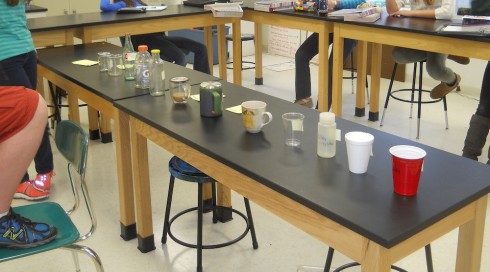
I gave the middle-schoolers twelve containers — cups, bottles, mugs, etc. — that I found around the classroom and asked them to figure out which one would keep in heat the best. In fact, I actually asked them to rank the containers because we’d just talked and read about thermal energy. This project is intended to have them learn about thermal energy and heat transfer, while discovering the advantages of the scientific method through practice.
Day 1: Observation and Deduction: When I asked them to rank that containers based on what they knew, I’d hoped that they’d discuss the thermal properties of the cups and bottles. And they did this to a certain degree, however, part of their reasoning for the numbers one and two containers, were that these were the ones I used. Indeed, since I use the double walled glass mug with the lid (container number 7) almost every day, while I only use the steel thermos-mug (container number 6) on field trips (see here for example), they reasoned that the glass mug must have better thermal properties.

Day 2: Exploratory Science and Project Organization: On day 2, I asked the class to see how good their ranking of the containers was by actually testing them. Ever since the complex machines project where they had to choose their own objective, they’ve been wanting more independence, so I told them to pretend I was not in the room. I was not going to say or do anything to help, except provide them with a hot plate and a boiling kettle, and keep an eye out for safety.
They got to work quickly. Or at least some of them did while the other half of the class wondered around the room having their own, no-doubt important, conversations. I pulled them all back in after about half and hour to talk about what had happened. But before we discussed anything, I had them write down — pop quiz style — what their procedure was and how it could be improved. The vagueness of some of the answers made it obvious to both to me and the ones who had not been paying attention who’d actually been working on the project.
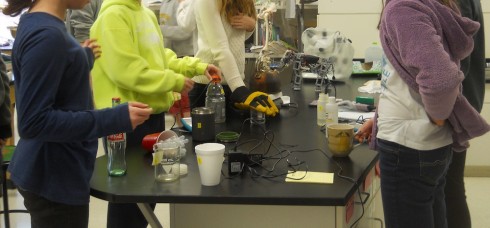
Of the ones who’d been working in the project, I brought to their attention that they’d not really spent any time planning and trying out a procedure, but they’d just jumped right in, with everyone following the instructions of the one student who they usually look to for leadership. Their procedure, while sound in theory would have benefited from a few small changes — which they did recognize themselves — and the involvement of more of the class. In particular, they were trying to check the temperature of the water every 10 seconds, but it would take a few seconds to unscrew lids, and about 5 additional seconds for the thermometer to equilibrate. They also were restricted because they were all sharing one stopwatch while trying to use multiple thermometers.
Day 3: First Iteration: Now that they’ve had a bit of trial by fire, tomorrow they’ll try their testing again. I’m optimistic that they’ve learned a lot from the second day’s experience, but we’ll see how it turns out.
Resurrecting the Orchard
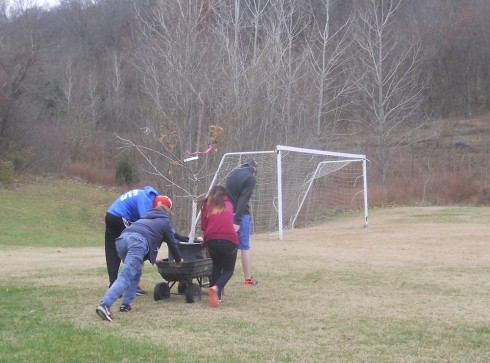
The last few years have, unfortunately, been ones of neglect for the orchard. The trees were planted about five years ago, but because of changes in the faculty I ended up in charge of it. Unfortunately, with projects like the invasive species remediation and the working out how to use the surveying equipment I have not had the opportunity to turn my full attention to the needs of the fruit trees.
Enter Dr. Sansone. He’s been my key resource for a few of my earlier farm-school type projects (see chickens and rabbits). But, apart from livestock he also has a keen interest in organic agriculture including fruit and berry trees. He’s been helping clearing the brush from the orchard, spraying the trees for to get rid of and prevent disease, and he managed to get the donation of a new apple tree from the Frisella Nursery, just across the Missouri River from us in St. Charles.
The new tree is particularly valuable because it’s a good pollinator.
Dendrochronology with Bradford Pears
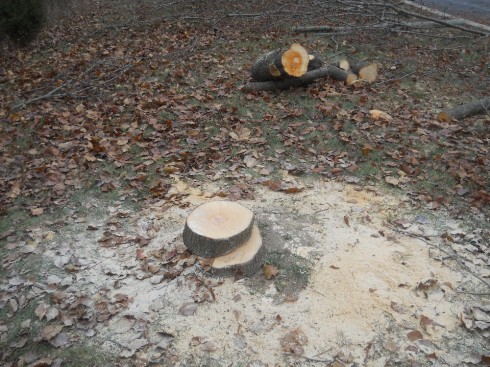
With the help of Scott Woodbury from the Shaw Nature Reserve, Dr. Sansone lead the effort to remove the six mature Bradford Pear trees from the front of the school over the last interim. We collected slices of each of the trees so students could do a little dendrological work with the tree rings.
The trees were planted as part of the original landscaping of the school campus. They’re pretty in the spring and fall, but are an aggressive invasive species.
The fast growth, however, make for wide growth rings. In fact, in addition to the annual rings, there are several millimeter wide sub rings that are probably related to specific weather events within the year. I’d like to see if we can co-relate some of the sub-ring data to the longer term instrumental record of the area.
The tree cutting was quite fun as well, despite being done on a cold day near the end of November. Students helped stack logs and organize branches along the road for the woodchipper. I learned how to use a chainsaw.
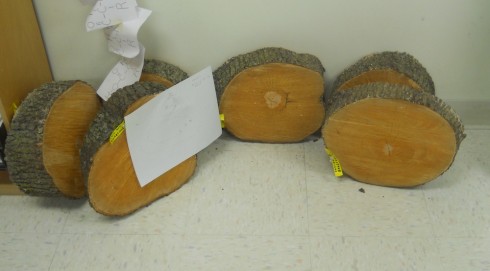
The Science of Cookies
We’ve looked at the simple acid/base reactions that produce the carbon dioxide bubbles in chocolate-chip cookies, but this video goes over a number of other relevant chemical concepts and the temperatures at which changes occur, including:
- Emulsions: butter is an emulsion that separates into its constituent fats and water at 92ºF,
- Denaturing proteins: at 144ºF proteins denature and then coagulate,
- Evaporation: at 212ºF
- Carbon dioxide production: from the reaction of baking soda and acid in the dough
- Maillard reactions: at 310ºF amino acids and denatured proteins react with sugars to brown the cookies and create lots of excellent flavors
- Caramelization: at 356ºF sugars break down and reform into interesting, tasty compounds
Using Simple Machines to get a Car out of a Lake
Application of a lever and a wheel and axle to get a car out of a frozen lake.
Biochemical Art
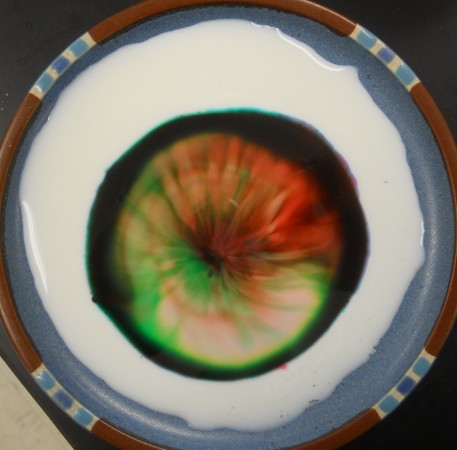
A beautiful demonstration of the interaction between detergents and fats (in milk). The food coloring acts as a tracer.
Girl Awesomeness
Ms. Hahn shared this with me because, “This video — in all of its girl awesomeness — reminded me of your recent Rube Goldberg blog entry and my visit to your classroom to see your middle school students’ “machines.” Entertaining.”